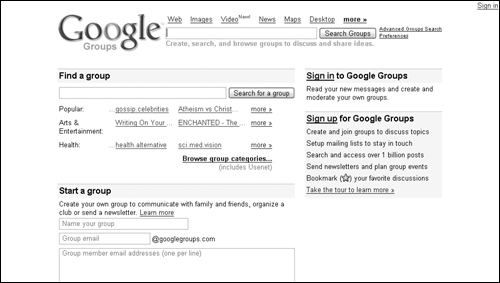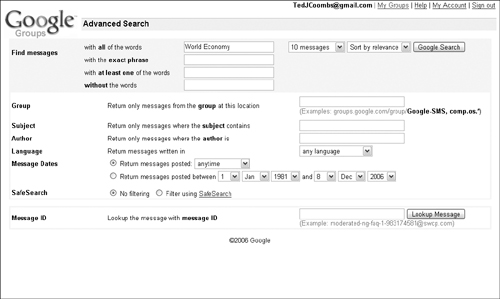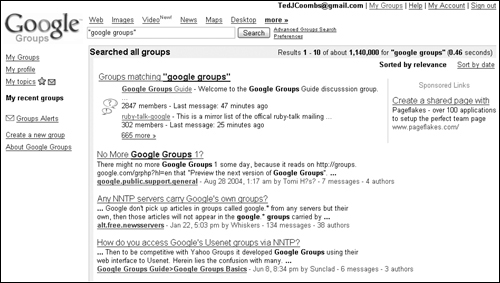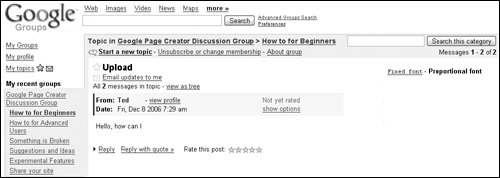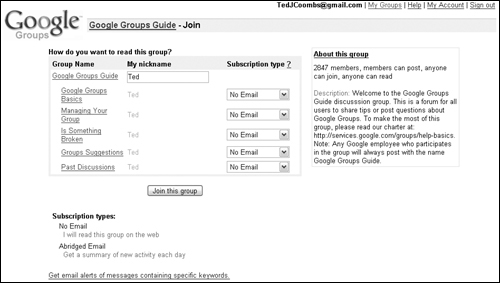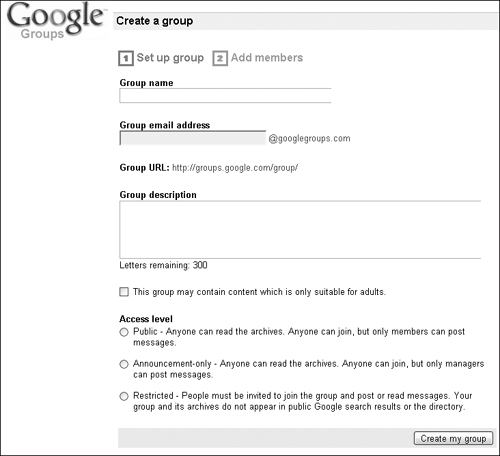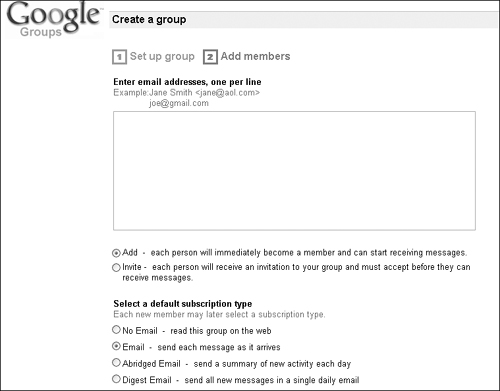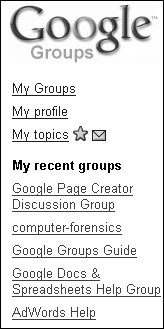How Usenet has been transformed for Google Groups
Searching Google Groups and nearly the entire archive of Usenet postings
Understanding your Google Group search results
Finding and joining Google Groups
Creating and managing your own Google Group
Creating mailing lists and newsletters using Google Groups
Google Groups, formerly DejaNews, maintains an interface to Usenet News groups created by Google members and mailing lists. Google Groups also maintains an archive of postings to Usenet dating back to 1981, nearly from the beginning of Usenet itself. For more information about Usenet, read “Introducing Usenet” at the beginning of this chapter. Point your Web browser to http://groups.google.com. You don’t need to have a Google account to use Google Groups, but extra features are available when you do have an account. Figure 22.1 shows how you can search through all the groups for information or find a group that interests you.
Usenet is one of the earliest Internet applications. Most people think of the Internet as just e-mail and the Web, but Usenet was around long before the World Wide Web. Usenet is based on the idea of the computer bulletin board, the way people who had computers communicated with each other before the invention of the Internet.
Bulletin board software allowed people to dial into a central computer (run by someone “running a bulletin board”) and post messages. People also could download their favorite games, software, and messages sent to them by others. Some bulletin board software even allowed people to chat with one another. Usually, in the middle of the night, bulletin board programs would dial out and connect to other bulletin boards transferring messages until they eventually hopped their way to the intended recipient. This was known as store and forward. This method of transferring messages became the foundation of the way e-mail and Usenet groups work today. They both use the store-and-forward method for transferring messages. E-mail works by hopping a message to the intended e-mail server and stores it there until someone contacts the server and downloads the messages. This way, messages can be sent without the recipient’s computer being connected to the server, which in the old days of computers, they rarely were. For this reason, you can find many parallels between the way e-mail and Usenet both operate.
Internet researchers at Duke University created a store-and-forward system for posting messages based on topics, and the topics are organized into a tree-structured hierarchy. For example, the top of one of the trees is called sci. No one posts directly to sci, but the sci group has subgroups, all related to science. Each subgroup is connected to its parent group name by a dot. For example, sci.math is a Usenet group for people interested in mathematics. Subgroups also can have subgroups. This group is for people interested in electronic design: sci.electronics.design. There is a catchall group named alt. The alt (alternate) group contains just about anything you can imagine: alt.battlestar-galactica, for example.
Messages sent to these groups are sent to Usenet News servers (technically called NNTP servers). Usenet News was the full name of the Internet application, and the servers are often simply called News servers. They never really carried breaking news as you may think of news, but they certainly contained news related to very specific topics.
You can send only text to Usenet servers. Wait! Don’t throw this book into the fire just yet. Yes, you can download images, sound files, programs, and even video from Usenet groups, but they are first encoded into text, the form they take when being stored on Usenet servers. Usenet client programs, simply known as newsreaders, decode the text and change the graphics, binary programs, videos, and sound files back into their original form.
No matter what your interest may be, with tens of thousands of active groups and more than 100,000 archived groups, chances are high that you’ll find what you’re looking for in one of these groups. Being able to search through these groups is an amazing resource.
Google Groups is more than a Web-based interface to the Usenet News groups. It also includes groups created by Google members. Using Google Groups, you no longer need to use a separate newsreader program to view the contents of a group, post messages to the group, or even create your own group. In fact, you can’t access Google’s groups using a newsreader. You can only use the Web interface at http://groups.google.com.
Note
Google does not fully participate in Usenet. Groups created by Google users do not become part of Usenet. They remain part of Google Groups. You can’t access Google-created groups using a newsreader program, and they don’t appear on other NNTP servers.
You can think of Usenet as a subset of Google Groups. To truly participate fully in Usenet, you need access through a different NNTP server. Usenet service is offered by some Internet service providers. These services usually offer only a limited subset of the groups. For full access to all the groups, you can search the Web for Usenet servers and find a list of services that charge a small fee to access all the groups. You need a newsreader like the one installed in Outlook Express to access these groups.
When Google purchased the DejaNews Web site in 2000, Google users got the ability to use Google’s powerful search technology to search through Usenet News, which Google then called Google Groups. Today, you can search back through 25 years of archived groups and the more recently created groups by Google and Google members.
Figure 22.1 showed two search boxes on the Google Groups page. The top search box allows you to search for information in all the Google Groups, while the second search box allows you to locate groups, rather than information. The section “Finding a Group,” later in this chapter, discusses finding Google Groups.
Type your search term or phrase in the Google Groups search box, and click Search Groups. Google does not have all the Usenet News groups as part of Google Groups. It maintains about 20,000 groups. Most of the missing groups are those that generally cater only to graphics, which are useless when doing a Google search. So, when you do your search, it looks through the 20,000 or so active Google Groups all the way back to 1981.
The Google Group Advanced Search is accessed by clicking the Advanced Groups Search link next to the Google Groups search box. The Advanced Groups Search page begins the same way that all the other advanced search pages begin: focusing your keyword search. Type information into any of the Find messages section boxes to focus by keyword.
You can further focus your search by limiting your search to a single group or to groups within a specific hierarchy of groups. For example, if you want to search only the groups in the science (sci) topic, type sci.* (* is a wildcard that applies to all subgroups) into the section labeled Group.
You can find messages that have your keyword in the subject, as opposed to the entire message. Type a keyword or phrase into the box in the Subject section of the Advanced Groups Search page.
You can limit your search based on author, language of the message, and message dates. You can specify message dates in two ways: manually enter a date range or select a range from the drop-down list, consisting of the following choices:
anytime (default)
past 24 hours
past week
past month
past 3 months
past 6 months
past year
Remember that when you select anytime, your search may go back as far as 1981. This advanced search feature is an excellent way to limit your search to more recent postings.
The advanced search also allows you to engage the Google SafeSearch option. This limits the messages you receive to those that do not contain text with adult-oriented explicit language.
Finally, you can search for a specific message when you know the message ID. This is useful when you want to go back and read a specific message to read responses posted about the original message. Find the message ID by:
Navigate to the message in Google Groups.
Click the show options link in the message.
Click the Show original link to display the unformatted version of the message.
Find the Message-ID line. The message ID looks something like this:
Message-ID: <[email protected]
When your search terms match the name of a Google Group, those results appear first. Figure 22.3 shows that searching on the phrase “google groups” matched the group named Google Groups Guide. This result came first.
The results that follow display individual message posts to various groups. The title of the message (similar to the subject of an e-mail message) appears as a link. Clicking the link displays the full content of the message. You can read a brief snippet of the message, the part of the message that includes your search term.
The last line of the result is a link to the group itself. The text that follows includes the date of the message, name or pseudonym of the person who posted the message, and how many messages can be found in the group. You also can see how many different people posted messages. For example, a group could have 100 messages with only two people posting to the group.
After you find a message that you want to read, whether by searching Google Groups or by browsing through the messages in the group, you can see the author’s name in the From field and the date the message was posted. Clicking the Show options link reveals more information, such as the poster’s e-mail address and the groups the message was posted to. It is possible to post the same message to multiple groups. Learn more on posting messages later in this chapter. Additionally, eight more links appear (see Figure 22.4):
Reply: Reply to this message, and have it posted as a message to the group.
Reply to author: Reply by e-mail only to the author of the message.
Forward: Send a copy of this message to yourself or someone else by e-mail.
Print: Print the message.
Individual Message: Show only the individual message and not the list of messages.
Show original: Display a raw copy of the message, unformatted, in a new window.
Report abuse: Let Google know when someone is posting material that should not be posted.
Find messages by this author: This handy feature allows you to see messages in all groups by the person who posted the message you are reading.
Participating in groups is very much like using e-mail, particularly Gmail, because Gmail messages are shown as threaded discussions.
Instead of finding information in many groups, you may simply want to find a group that interests you. On the left side of the Google Groups home page, click the My Groups link. In the Find a group search box, type a topic and click Search for a group. The results first display topics that pertain to your search term. Next to each topic is a number in parentheses indicating the number of groups found related to that topic. The number also may represent several possible subgroups, each containing several possible groups.
Clicking any of these topics allows you to focus your search by navigating down a particular hierarchy of groups until you find the group or groups that interest you.
There may be several group topics that contain your search term. For example, searching on Ventura can bring up groups that focus on Ventura Publishing, a software package, or Ventura, California, and whatever else that could share the term, even Ace Ventura, Pet Detective. If you are searching for software, then you want to focus on the topics that deal with computers.
In addition to topics, the result page also displays languages that you can choose. Groups listed under this heading are in the language you select. You also can choose the level of activity the group experiences. It’s not very interesting to join a group that sees one post a year, so you probably want to choose groups with higher levels of activity. The levels include:
High
Medium
Low
Just like activity levels, you may want to see groups that have a certain number of members posting messages. You can select groups with higher numbers of members by selecting one of the links in the Members section showing the minimum number of members; 100+, 10-100, and less than 10.
The list of groups appears in the next section of the results page. If you are curious as to why a particular group is included, click the Show matching messages from this group link next to the group name and see the messages that match your search term.
Also shown in the results for each group is the following information: the category, the group language, the level of activity, the number of subscribers, and whether it is a Usenet or Google group. Some groups show that they are restricted. This means that you must get permission from the group moderator before you can participate in the group.
Many groups require that you become a member of the group before you can post to the group. This is similar to moderated Usenet groups. The moderator can choose who is allowed to read or post messages to the group. In some cases, the moderator is allowed to review the messages and reject those not desirable for the group. Google Groups calls these restricted groups. The group owner may elect to have the group be restricted. When you must first become a member of the group you will see the following message: You cannot post messages because only members can post, and you are not currently a member.
To post to a restricted group you must first join the group. Visit the group’s home page, and click Join this group. You may first want to click the About group link to learn more about the group before joining. Clicking the Join this group link launches the group’s Join page. Here you can set the nickname that will appear in posts by you to this group and select the manner in which you receive or view messages from the group. The choices are: No Email and Abridged Email. When you have finished configuring the Join options click Join this group (see Figure 22.5).
You can participate in Google Groups in an active way by creating your own groups. Read the other groups in your topic area before creating a group so you aren’t simply duplicating a group that already exists. Still, there are no restrictions to creating similar groups. Creating groups is a two-step process: Create the group, and then add members to the group.
You can create a group in two ways:
From the menu on the left side of the search results page, click the Create a new group link.
Complete the Start a Group section on the Google Groups home page (see Figure 22.6).
When you’re ready to begin, follow these steps:
Give the group a name. Type a name into the box labeled Group name. Names must be a single word or words separated by a dash. The name you type appears in the Group e-mail address box. The name of the group automatically becomes the group’s e-mail address. For example, a group named Black-Cats is given a group e-mail address of
[email protected].Note
The group URL cannot be edited; it is simply displayed for you. In the case of the Black-Cats group, the URL would be http://groups.google.com/group/black-cats.
Type a description of the group. You have 300 characters in which to provide a description of what people will find posted in this group. The group description can be the most important part of having a successful group. Take your time with this step.
If your group contains information not suitable for children, select the This group may contain content which is only suitable for adults checkbox.
Set the access level to the group. You can only select one of the three levels of access by selecting the radio button next to the selection:
Public: Anyone can read and join; members can post.
Announcement-only: This group is created for making announcements. It is public, but only the group owner can post.
Restricted: People must be invited to join the group before they can read messages or post to the group.
Click Create my group. If there are duplicate names or errors in the form, Google helps you complete the page. Look for the red message below one of the boxes on the page.
When the group is successfully created, you can begin adding group members. You will receive an e-mail message confirming that the group has been successfully created.
After you create your group, you can start adding members. Only members of your Google Group can post messages. This is where Google groups are different from Usenet groups, which allow anyone to post to unmoderated newsgroups.
Add members by typing the name and e-mail address of the member in this format:
first last <[email protected]>. You also can simply add just the e-mail address like this:[email protected].Add addresses, one per line, in the box provided. When you finish adding members (and you can add more later), choose whether these people are simply added as members or invited to join the group. When you add them, they become members automatically. When you invite them, they receive an invitation via e-mail and must accept your invitation before they can begin viewing group messages.
Set a default subscription type for the members joining your group. They can change their subscription type after becoming members. These are the subscription choices:
No email: Read this group on the Web.
Email: Send each message as it arrives to the member via e-mail.
Abridged email: Send a brief summary of the day’s messages once per day.
Digest email: Send an archive of the day’s messages once per day via e-mail.
Type a welcome message that each new member receives via e-mail after joining the group.
There is no need to type the name of the group, the group home page URL, or its e-mail address; these are sent as part of the welcome message by Google. This is a good place to describe your vision for the kinds of information you want to see posted and any restrictions you want to add.
Click Done. You have successfully created your Google Group and let prospective members know about the group.
When you click the My Groups link on the left side of the Google Groups page (see Figure 22.8), you see the list of groups you can manage with a manage link displayed next to the group name. Clicking this link takes you to a summary page of the settings for all your groups. Select one of the areas to be managed, and click the Edit link in the upper-right corner of the section you want to edit.
You have more configuration choices when managing the group than when you first created the group.
Tip
After creating the group, immediately edit the group settings to take advantage of the increased number of configuration settings.
In addition to changing the group description, access settings, e-mail, and group language, as a manager you also can browse the membership list by clicking the link in the Members section of the group’s manage page. You also can invite or add members by clicking the Invite or Add members link in this section.
After you begin managing a group and access this page, you can see a list of your outstanding tasks. For example, you might have on your tasks list to approve messages when your list is moderated or to approve membership requests when access to your group is restricted. You see these in the Tasks section of the manage page.
It’s a good idea to begin your group by posting the first message to the group. You do not have to repeat what you put in the group description. Just begin the discussion of a topic in which you think others will be interested.
When you create a Google Group, you create a type of mailing list. Mailing lists are composed of members who join the list. Most mailing lists allow you to receive individual messages as they are sent or to receive a digest of the messages. Google Groups actually gives you two more choices: reading your messages on the Web and receiving a summary of the messages.
There are many parallels to running a Google Group and managing an e-mail list. You can moderate the messages sent to the group, restrict access to the list, or allow anyone to opt in to the list. To opt in means to choose to be part of a list, unlike spam messages that make you a member and then force you to opt out to stop receiving unwanted e-mail.
Note
It is possible to create a spam list using Google Groups, but it’s against the law and against Google policy.
Follow all the steps earlier in this chapter for creating a group. When you create the group, think of the group as an e-mail list rather than as a passive place to post messages, and configure the group with this in mind.
The main difference between using Google Groups as mailing lists is that most mailing list managers have special e-mail addresses where commands can be sent. Some of the commands understood by these list manager programs include the ability to unsubscribe from the list, change to receiving real-time or digest messages, and choose the message format—text or HTML. Your list members need to use their Google Groups Web interface to change their settings.
Newsletters are a little like mailing lists with one difference: They tend to be messages sent by the group manager to the members of the group, not from the group members to all the other members of the group.
When you create a Google Group for the purposes of creating a newsletter, you should set the following restrictions:
Group Description: The description of the group should clearly specify that the purpose of the group is to act as a newsletter.
In the access settings configure the following:
Who can view: Set this to Only members can view group content.
Directory Listing: If this is a private newsletter, set this to Do not list this group.
Who can join: This is up to you. You can leave the newsletter very public or restrict access to your newsletter by changing this setting.
Who can post messages: This is the most important setting. Set this to Managers only.
Message moderation: This setting is less important because only the group manager can post messages.
You can choose to add people to your newsletter or invite them to receive it using the same procedure as adding and inviting people to your Google Group, because that’s what this is.
Google Groups allows you to participate in discussions that span tens of thousands of topics. These topic groups include a great number of the Usenet groups as well as proprietary Google Groups. You can search through Usenet all the way back to 1981 or choose to read current postings.
Create your own Google group that can act like a Usenet group, an e-mail mailing list, or a newsletter. Make sure you sign up for your Google Group promotion box so you can advertise your group on your personal Web page created using Google Page Creator, which is covered in the next chapter.

